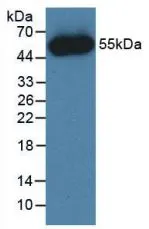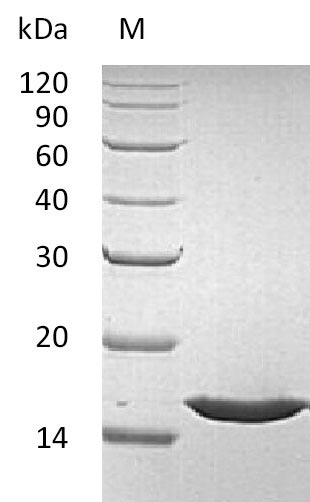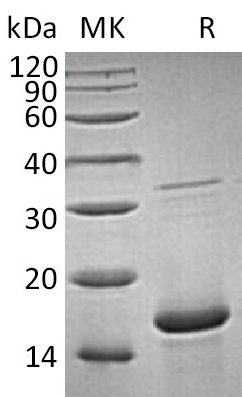
WB analysis of GTX00081-pro Human FGF1 protein (active).
Human FGF1 protein, His and GST tag (active)
GTX00081-PRO
ApplicationsFunctional Assay
Product group Proteins / Signaling Molecules
Protein IDP05230
Overview
- SupplierGeneTex
- Product NameHuman FGF1 protein, His and GST tag (active)
- Delivery Days Customer9
- Application Supplier NoteFGF1 (Fibroblast growth factor 1) is a member of FGF family, which plays an important role in the regulation of cell survival, cell division, angiogenesis, cell differentiation and cell migration. FGF1 is thought to stimulate the proliferation of 3T3 fibroblasts, besides, human FGF1 and mouse FGF1 shares similarities in amino acid sequence with the identity of 96% . Thus, a cell proliferation assay was conducted to detect the bioactivity of recombinant human FGF1 using 3T3 fibroblasts. Briefly, 3T3 cells were seeded into triplicate wells of 96-well plates at a density of 2000 cells/well and allowed to attach overnight, then the medium was replaced with serum-free standard DMEM prior to the addition of various concentrations of FGF1. After incubated for 48h, cells were observed by inverted microscope and cell proliferation was measured by Cell Counting Kit-8 (CCK-8). Briefly, 10 microl of CCK-8 solution was added to each well of the plate, then the absorbance at 450nm was measured using a microplate reader after incubating the plate for 1-4 hours at 37C. Proliferation of 3T3 cells after incubation with FGF1 for 48h observed by inverted microscope. Cell viability was assessed by CCK-8 (Cell Counting Kit-8 ) assay after incubation with recombinant FGF1 for 48h. And FGF1 significantly increased cell viability of 3T3 cells.
- ApplicationsFunctional Assay
- CertificationResearch Use Only
- ConjugateUnconjugated
- Protein IDP05230
- Protein NameFibroblast growth factor 1
- Scientific DescriptionThe protein encoded by this gene is a member of the fibroblast growth factor (FGF) family. FGF family members possess broad mitogenic and cell survival activities, and are involved in a variety of biological processes, including embryonic development, cell growth, morphogenesis, tissue repair, tumor growth and invasion. This protein functions as a modifier of endothelial cell migration and proliferation, as well as an angiogenic factor. It acts as a mitogen for a variety of mesoderm- and neuroectoderm-derived cells in vitro, thus is thought to be involved in organogenesis. Multiple alternatively spliced variants encoding different isoforms have been described. [provided by RefSeq, Jan 2009]
- Storage Instruction-20°C or -80°C,2°C to 8°C
- UNSPSC12352202







